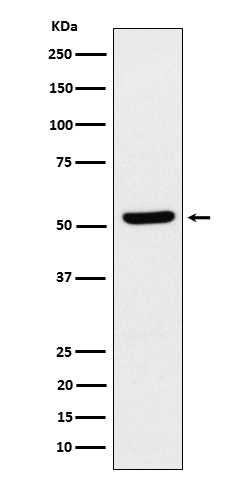产品名称
ZNF259 (14Z6) Rabbit Monoclonal Antibody
纯度
Affinity-chromatography
存储缓冲液
Rabbit IgG in phosphate buffered saline , pH 7.4, 150mM NaCl, 0.02% New type preservative N and 50% glycerol. Store at +4°C short term. Store at -20°C long term. Avoid freeze / thaw cycle.
Human Swissprot No.
O75312
稀释度
WB 1:500~1:2000 IHC 1:50~1:200
注意事项
ZNF259 Antibody is for research use only and not for use in diagnostic or therapeutic procedures.
组织表达
Expressed in fibroblast; weakly expressed in fibroblast of spinal muscular atrophy (SMA) patients
细胞定位
Nucleus. Nucleus, nucleolus. Nucleus, gem. Nucleus, Cajal body. Cytoplasm, perinuclear region. Cytoplasm. Cell projection, axon. Cell projection, growth cone. Note=Colocalized with SMN1 in Gemini of coiled bodies (gems), Cajal bodies, axon and growth cones of neurons (By similarity) Localized predominantly in the cytoplasm in serum-starved cells growth arrested in G0 of the mitotic cell cycle. Localized both in the nucleus and cytoplasm at the G1 phase of the mitotic cell cycle. Accumulates in the subnuclear bodies during progression into the S phase of the mitotic cell cycle. Diffusely localized throughout the cell during mitosis. Colocalized with NPAT and SMN1 in nuclear bodies including gems (Gemini of coiled bodies) and Cajal bodies in a cell cycle- dependent manner. Translocates together with EEF1A1 from the cytoplasm to the nucleolus after treatment with mitogens. Colocalized with EGFR in the cytoplasm of quiescent cells. Translocates from the cytoplasm to the nucleus in a epidermal growth factor (EGF)-dependent manner
功能
Acts as a signaling molecule that communicates proliferative growth signals from the cytoplasm to the nucleus. Plays a role for the localization and accumulation of the survival motor neuron protein SMN1 in sub-nuclear bodies, including gems and Cajal bodies. Induces neuron differentiation and stimulates axonal growth and formation of growth cone in spinal cord motor neurons. Plays a role in the splicing of cellular pre-mRNAs. May be involved in H(2)O(2)-induced neuronal cell death.

